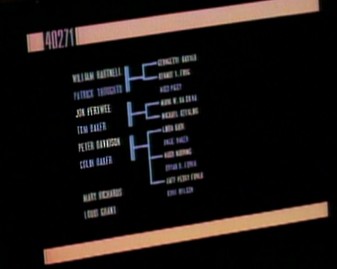Science Fiction
Dictionary
A B C D E F G H I J K L M N O P Q R S T U V W X Y Z
Genealogy DNA Databases Trek-Style

DNA-based genealogy databases that offer ancestral matches based on your personal sample are expanding.
The basics of genetic ancestry testing are this: scientists search for genetic markers that appear more frequently in one population than in another. By combining the information gleaned from a number of markers--anywhere from tens to thousands--researchers can estimate the percentage of an individual's ancestry from different parent populations...
Now, both the scope and resolution of genomic ancestry studies are growing dramatically, thanks to specially designed microchips that allow scientists to quickly scan hundreds of thousands of spots on an individual's genome. That means that researchers can gather genetic information from more people in more places, generating better ancestry markers.
Although the testing still offers a probabilistic view of your ancestry; it tells where your ancestors are most likely from, not exactly who they are.
In the Star Trek: The Next Generation episode The Neutral Zone, counsellor Troi uses a genealogy computer to immediately display the family tree of someone who was revived after 400 years. The information for all of her descendants was displayed immediately.
New technologies are allowing scientists to search for markers across the genome that can more precisely predict ancestry. Much of that data is being poured into public databases, supplying much more accurate and detailed information to genetic-testing companies and new consumer tests.

(ST: TNG Genealogy display from The Neutral Zone)
The following video excerpt shows the relevant bit.
(The Neutral Zone excerpt [2'20"] )
Via Genealogy Gets More Precise: Rapidly growing databases enable a more complete picture of one's ancestry; thanks to Moira for the tip.
Scroll down for more stories in the same category. (Story submitted 9/4/2008)
Follow this kind of news @Technovelgy.| Email | RSS | Blog It | Stumble | del.icio.us | Digg | Reddit |
Would
you like to contribute a story tip?
It's easy:
Get the URL of the story, and the related sf author, and add
it here.
Comment/Join discussion ( 0 )
Related News Stories - (" Medical ")
Natural Gait With Prosthetic Connected To Nervous System
'The leg was to function, in a way, as a servo-mechanism operated by Larry’s brain...' - Charles Recour, 1949.
Brain Implant Is Able To Capture Your Inner Dialogue
'So you see, you can hide nothing from me.'
'Pregnancy Humanoids' From China Replace Moms
'A great many of these synthetic babies were made...' - David H. Keller, 1928.
Bacteria Turns Plastic Into Pain Relief? That Gives Me An Idea.
'I guess there's nobody round this table who doesn't have a Crosswell [tapeworm] working for him in the small intestine.'
Technovelgy (that's tech-novel-gee!) is devoted to the creative science inventions and ideas of sf authors. Look for the Invention Category that interests you, the Glossary, the Invention Timeline, or see what's New.
Science Fiction
Timeline
1600-1899
1900-1939
1940's 1950's
1960's 1970's
1980's 1990's
2000's 2010's
Current News
Natural Gait With Prosthetic Connected To Nervous System
'The leg was to function, in a way, as a servo-mechanism operated by Larry’s brain...'
Woman Marries Computer, Vonnegut's Dream Comes True
'Men are made of protoplasm... Lasts forever.'
Spidery 'Walk Me' Toyota Autonomous Wheel Chair Like Star Wars
Walk along with the emperor.
Dancing Robots Taught Dance Moves
'A clockwork figure would be the thing for you...'
Proof Of Robothood - Not A Person
'Who are you people? - Show 'em.'
Indonesian Clans Battle
'The observation vehicle was of that peculiar variety used in conveying a large number of people across rough terrain.'
The 'Last Mile' In China Crowded With Delivery Robots
Yes, it's a delivery robot. On wheels.
Tornyol Microdrone Kills Mosquitoes
'The real border was defended by... a swarm of quasi-independent aerostats.'
PLATO Spacecraft, Hunter Of Habitable Planets, Now Ready
'I ... set my automatic astronomical instruments to searching for a habitable planet.'
Factory Humanoid Robots Built By Humanoid Robots
'...haven't you a section of the factory where only robot labor is employed?'
iPhone Air Fulfils Jobs' Promise From 2007 - A Giant Screen!
'... oblongs were all over the floor and surfaces.'
ChatGPT Now Participates in Group Chats
'...the city was their laboratory in human psychology.'
iPhone Pocket All Sold Out!
'A long, strong, slender net...'
Did The Yautja Have These First?
What a marvel of ingenuity the little device was!
Jetson ONE Air Races Begin, Can Air Polo Be Far Behind?
'If you're one of those rarities who haven't attended a rocket-polo "carnage", let me tell you it's a colorful affair.'
Will Space Stations Have Large Interior Spaces Again?
'They filed clumsily into the battleroom, like children in a swimming pool for the first time, clinging to the handholds along the side.'
